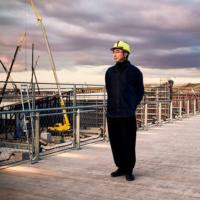While he was in Washington last weekend to pick up this year's gold medal from the American Institute of Architects, Mr. Tadao Ando jumped into the debate about what should replace New York's World Trade Center towers. According to the celebrated Japanese architect, this is not a moment for celebrity architecture. It is a moment for remembrance, for reflection, for "stimulating people to think about how they are going to live together on this planet." He therefore suggested a 10-story-high, 200-meter-wide, grass-covered mound, a bit like an ancient burial mound but also the visible cap of an invisible sphere whose radius would be one-thirty-thousandth of the radius of the planet.
The Washington Post immediately dubbed the plan "Ando's hill on the city" -- a hint, perhaps, that it might strike New York City officials as a bit quixotic. In truth, it is hard to imagine authorities letting 6.5 hectares of land-hungry Lower Manhattan stand empty, no matter how resonant the emptiness. Yet the timing of the suggestion (after six months of argument), its extreme simplicity and Mr. Ando's current stature in the United States are likely to ensure that it gets attention.
At the very least, it brings into focus several strands of the debate that has absorbed architects, city planners and ordinary New Yorkers ever since Sept. 11 and is coming to a head now that it appears the site will be cleared as early as June. Mr. Ando's idea does not drop into a vacuum.
















With your current subscription plan you can comment on stories. However, before writing your first comment, please create a display name in the Profile section of your subscriber account page.